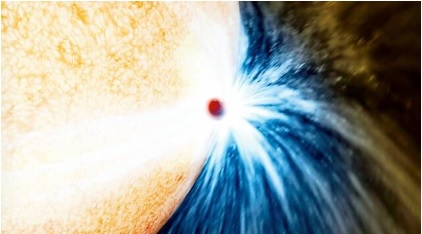Important Facts For Prelims
Star Engulfing Jupiter-Sized Planet
- 09 May 2023
- 5 min read
Why in News?
According to a recent study, scientists have observed a bloated Sun-like star, identified as ZTF SLRN-2020, swallowing a Jupiter-sized planet, causing the star to expel some material into space in an energetic belch.
- The researchers used the Zwicky Transient Facility (ZTF) at Caltech's Palomar Observatory to spot the star rapidly become 100 times brighter, then figured out why this happened.
What are the Findings of the Study?
- Star:
- The star is similar to our sun in size and composition and is located in our Milky Way galaxy about 12,000 light-years from Earth in the direction of the constellation Aquila.
- A light year is the distance light travels in a year, 5.9 trillion miles (9.5 trillion km).
- The star is around 10 billion years old, twice as old as the sun.
- The constellation Aquila, the eagle, is visible in the northern hemisphere from July through October. It is a mid-sized constellation, spanning 652 square degrees of the sky.
- The star is in the early stages of the red giant phase, which means that it was bloated in its old age and had depleted hydrogen fuel in its core, causing its dimensions to expand.
- Red giant stars can swell to a hundred times their original diameter, engulfing any planets in their way.
- Mercury, Venus and finally Earth, our solar system's three innermost planets, will meet this destiny as the sun evolves through its red giant phase in about 5 billion years.
- The star is similar to our sun in size and composition and is located in our Milky Way galaxy about 12,000 light-years from Earth in the direction of the constellation Aquila.
- Star Engulfing the Planet:
- As the star grew, the planet's orbit brought it too close, and it started getting pulled into the star's atmosphere. The closer it got, the faster it was pulled in, causing it to plunge into the star suddenly, creating the emission of intense radiation.
What is the Life Cycle of a Star?
- Birth: A star's life cycle begins with a Nebula, where gravity pulls gas and dust together to form a protostar.
- Nebulae are huge clouds of gas and dust.
- Main Sequence Stage: When the core gets hot enough, Nuclear Fusion starts, and the star enters the main sequence stage.
- During the main sequence stage, the star burns hydrogen in its core, producing energy that keeps the star stable and shining brightly.
- Smaller stars burn fuel slowly and can shine for billions of years, while massive stars burn it fast and may only last for hundreds of thousands of years.
- Old Age and Death: As a star's hydrogen runs out, it expands and cools, becoming a red giant. Smaller stars turn into a planetary nebula, then a white dwarf, and eventually a black dwarf.
- More massive stars explode as a supernova, scattering materials into space, and leaving behind a neutron star or a black hole.
UPSC Civil Services Examination Previous Year Question (PYQ)
Q. Recently, scientists observed the merger of giant ‘blackholes’ billions of light-years away from the Earth. What is the significance of this observation? (2019)
(a) ‘Higgs boson particles’ were detected.
(b) ‘Gravitational waves’ were detected.
(c) Possibility of inter-galactic space travel through ‘wormhole’ was confirmed.
(d) It enabled the scientists to understand ‘singularity’.
Ans: (b)
- Every few minutes a pair of black holes smash into each other. These cataclysms release ripples in the fabric of space time known as gravitational waves.
- Gravitational waves are ‘ripples’ in space-time caused by some of the most violent and energetic processes in the Universe. Albert Einstein predicted the existence of gravitational waves in 1916 in his General Theory of Relativity.
- The strongest gravitational waves are produced by catastrophic events such as colliding black holes, the collapse of supernovae, coalescing neutron stars or white dwarf stars, etc.
- Scientists have yet again detected gravitational waves produced by the merger of two light black holes about a billion light-years away from the Earth.
- It was recorded by Laser Interferometer Gravitational‑Wave Observatory (LIGO).
- Therefore, option (b) is the correct answer.








